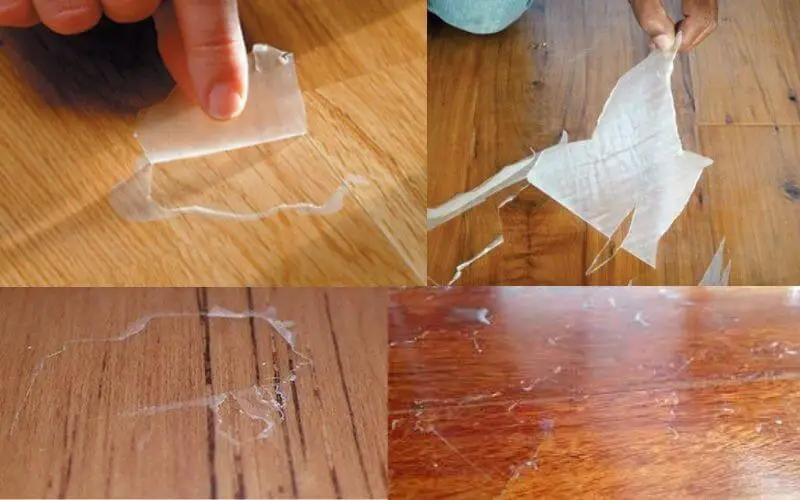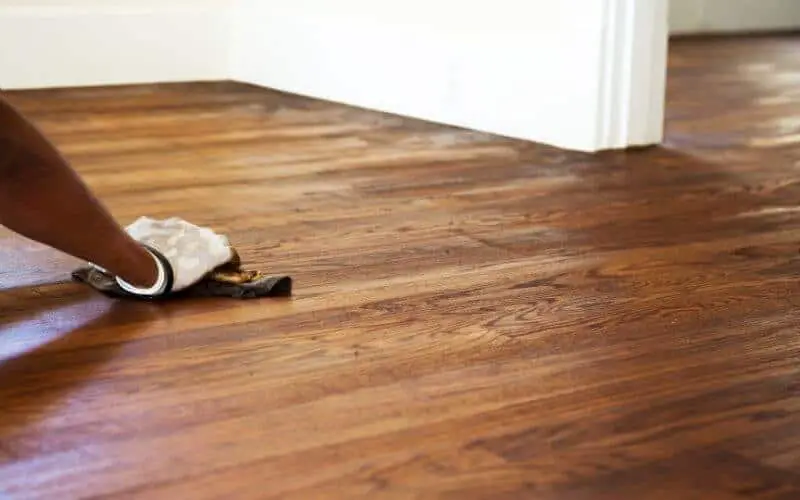Polyurethane is one of the most durable finishes you can apply to your hardwood. Other finishes include varnish, wax, penetrating oil, aluminum oxide, etc.
A new coat of polyurethane adds another layer of protection to your floors, which extends the life of the floors, usually for another 3-5 years.
As durable as polyurethane is, it can peel due to circumstances such as not cleaning it regularly. Let’s look into how to fix peeling polyurethane on hardwood floors.
Removal of the old finish, restaining the hardwood floor, and resealing the floor with polyurethane are steps to fixing peeling polyurethane on hardwood floors.
Related: How long to wait between coats of polyurethane
Different Types of Polyurethane
Table of Contents
It is important to note that there are two types of polyurethane finish: oil-based poly and water-based poly. To get the perfect color without going through much stress, an oil-based poly is probably the better option.
Choosing a water-based poly is better if you want a less glossy outlook. Oil-based polyurethane lasts longer than water-based polyurethane. Water-based polys are more expensive but contain less toxicity than oil-based polyurethane.
Areas with lots of traffic often require more durable polyurethane and offer more protection against heat and moisture.
Water-based polyurethane is often preferred by those who want to maintain the natural color of the wood. To fix peeling polyurethane on hardwood floors, you must remove the old finish.
What are the Causes of Peeling Polyurethane on Hardwood Floors?
Polyurethane peeling on hardwood floors can be problematic for professional floor finishers. There are several reasons why a newly applied polyurethane would peel.
We would list and try to explain these reasons. Some of these reasons may include;
- There is some form of contamination on the wood surface that wasn’t spotted on time by the floor finisher before applying the polyurethane finish. This could lead to the peeling of polyurethane on hardwood floors.
- When the hardwood floor is not adequately abraded in-between application of different coats of polyurethane.
- When the floor finishers do not stick to the timeline of the manufacturers of the polyurethane coat, if you don’t apply the coating within the stipulated window, it could also lead to peeling.
- The compatibility of the different coats of polyurethane finish can also be a primary cause of peeling. This happens when the first coat interacts poorly with the newly applied coat.
- When the polyurethane finish is too much or not properly cleaned can also lead to peeling.
- Applying the wrong polyurethane finish can also cause polyurethane peeling on hardwood floors.
These scenarios painted above are some of the likely reasons for your peeling polyurethane finish. It must be adequately investigated to prevent a re-occurrence from solving the peeling problems.
Though popular, polyurethane contains harmful substances such as isocyanates, classified by health regulatory agencies as carcinogenic (likely to cause cancer).
Constant exposure to polyurethane can lead to lung cancer. Avoid using polyurethane as much as possible, but if you must, wear protective clothing such as goggles to protect your eyes, nose masks to limit your intake of polyurethane fumes, and gloves to protect your hands. Always work in a properly ventilated area.
Read: How to apply oil based polyurethane
How to Fix Peeling Polyurethane on Hardwood Floors
1. Removal of the Old Finish
When tackling a peeling polyurethane floor, the first thing to do is to remove the old one. This is achieved by sanding with a drum. Drum sanders are tools used to sand wood.
You fix the sandpaper on the drum sander, and you grind away. Certain chemicals are also used to remove peeling polyurethane floors.
These chemicals include mineral spirits, et cetera. Endeavor to have open windows if you choose to go with this option.
2. Re-staining the Hardwood Floor
After successfully sanding off the peeling polyurethane, the following line of action is to re-stain the hardwood floor.
You must ensure that the hardwood floor is adequately dried before re-staining to prevent a re-occurrence of the peeling. Staining provides a rich color to your natural wood.
Stain the wood as thinly as possible to enable the drying process. Oil-based stains are often regarded as the best wood stain for hardwood floors. They provide a richer color and an even finish.
Read: How to stain laminate floors
3. Resealing the Hardwood Floor with Polyurethane
While re-staining provides a rich color to your hardwood, it does not give long-lasting protection to your wood. A polyurethane finish provides that protection for your hardwood floors.
Before applying the polyurethane finish, ensure the hardwood floor is adequately dried.
You can install fans and dehumidifiers to aid the process, also make sure to use a polyurethane finish that is compatible with the staining product used earlier. Use an oil-based polyurethane for an oil-based stain for easy compatibility.
Read: How to fix peeling laminate floor
Conclusion
Inadequate abrading, applying a top coat over a floor that is not dry or working with the wrong kind of finishes, old age, incompatibility of the polyurethane coat with the previous stain can cause polyurethane floor to peel.
Also, not sticking to the timeline of the manufacturers of the polyurethane, contamination, etcetera are all leading causes of polyurethane peeling on hardwood floors.
The floor also finishes peel due to the contamination of the wood surface. As the article explained, the best way to fix a peeling floor is to sand it down to bare wood, re-stain with an oil-based stain, and apply the polyurethane after the paint is dried correctly.
Also listed in the article are practical ways on how to fix peeling polyurethane on hardwood floors.

